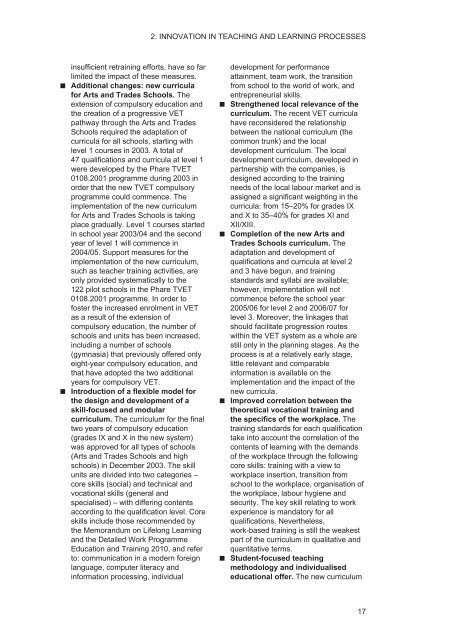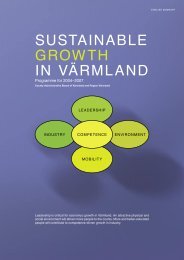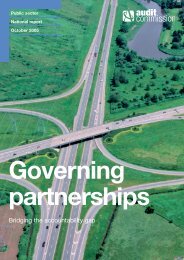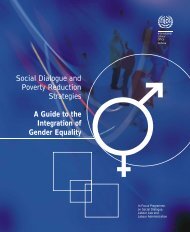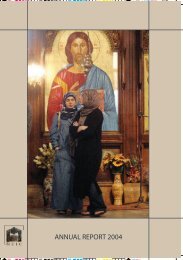PDF (222 KB) - Document Database website
PDF (222 KB) - Document Database website
PDF (222 KB) - Document Database website
You also want an ePaper? Increase the reach of your titles
YUMPU automatically turns print PDFs into web optimized ePapers that Google loves.
2. INNOVATION IN TEACHING AND LEARNING PROCESSES<br />
<br />
<br />
insufficient retraining efforts, have so far<br />
limited the impact of these measures.<br />
Additional changes: new curricula<br />
for Arts and Trades Schools. The<br />
extension of compulsory education and<br />
the creation of a progressive VET<br />
pathway through the Arts and Trades<br />
Schools required the adaptation of<br />
curricula for all schools, starting with<br />
level 1 courses in 2003. A total of<br />
47 qualifications and curricula at level 1<br />
were developed by the Phare TVET<br />
0108.2001 programme during 2003 in<br />
order that the new TVET compulsory<br />
programme could commence. The<br />
implementation of the new curriculum<br />
for Arts and Trades Schools is taking<br />
place gradually. Level 1 courses started<br />
in school year 2003/04 and the second<br />
year of level 1 will commence in<br />
2004/05. Support measures for the<br />
implementation of the new curriculum,<br />
such as teacher training activities, are<br />
only provided systematically to the<br />
122 pilot schools in the Phare TVET<br />
0108.2001 programme. In order to<br />
foster the increased enrolment in VET<br />
as a result of the extension of<br />
compulsory education, the number of<br />
schools and units has been increased,<br />
including a number of schools<br />
(gymnasia) that previously offered only<br />
eight-year compulsory education, and<br />
that have adopted the two additional<br />
years for compulsory VET.<br />
Introduction of a flexible model for<br />
the design and development of a<br />
skill-focused and modular<br />
curriculum. The curriculum for the final<br />
two years of compulsory education<br />
(grades lX and X in the new system)<br />
was approved for all types of schools<br />
(Arts and Trades Schools and high<br />
schools) in December 2003. The skill<br />
units are divided into two categories –<br />
core skills (social) and technical and<br />
vocational skills (general and<br />
specialised) – with differing contents<br />
according to the qualification level. Core<br />
skills include those recommended by<br />
the Memorandum on Lifelong Learning<br />
and the Detailed Work Programme<br />
Education and Training 2010, and refer<br />
to: communication in a modern foreign<br />
language, computer literacy and<br />
information processing, individual<br />
<br />
<br />
<br />
<br />
development for performance<br />
attainment, team work, the transition<br />
from school to the world of work, and<br />
entrepreneurial skills.<br />
Strengthened local relevance of the<br />
curriculum. The recent VET curricula<br />
have reconsidered the relationship<br />
between the national curriculum (the<br />
common trunk) and the local<br />
development curriculum. The local<br />
development curriculum, developed in<br />
partnership with the companies, is<br />
designed according to the training<br />
needs of the local labour market and is<br />
assigned a significant weighting in the<br />
curricula: from 15–20% for grades IX<br />
and X to 35–40% for grades XI and<br />
XII/XIII.<br />
Completion of the new Arts and<br />
Trades Schools curriculum. The<br />
adaptation and development of<br />
qualifications and curricula at level 2<br />
and 3 have begun, and training<br />
standards and syllabi are available;<br />
however, implementation will not<br />
commence before the school year<br />
2005/06 for level 2 and 2006/07 for<br />
level 3. Moreover, the linkages that<br />
should facilitate progression routes<br />
within the VET system as a whole are<br />
still only in the planning stages. As the<br />
process is at a relatively early stage,<br />
little relevant and comparable<br />
information is available on the<br />
implementation and the impact of the<br />
new curricula.<br />
Improved correlation between the<br />
theoretical vocational training and<br />
the specifics of the workplace. The<br />
training standards for each qualification<br />
take into account the correlation of the<br />
contents of learning with the demands<br />
of the workplace through the following<br />
core skills: training with a view to<br />
workplace insertion, transition from<br />
school to the workplace, organisation of<br />
the workplace, labour hygiene and<br />
security. The key skill relating to work<br />
experience is mandatory for all<br />
qualifications. Nevertheless,<br />
work-based training is still the weakest<br />
part of the curriculum in qualitative and<br />
quantitative terms.<br />
Student-focused teaching<br />
methodology and individualised<br />
educational offer. The new curriculum<br />
17


